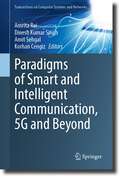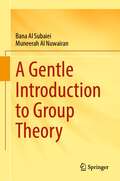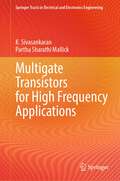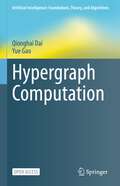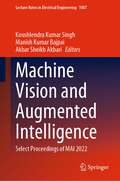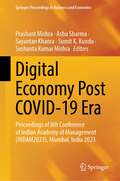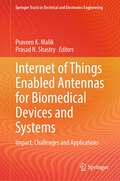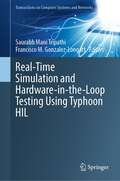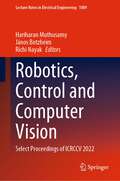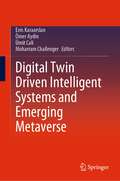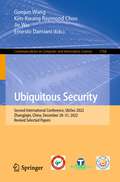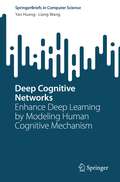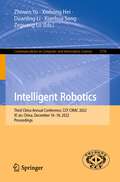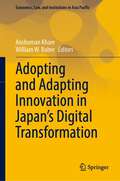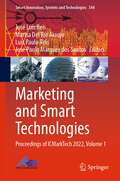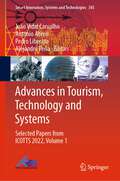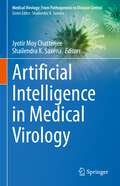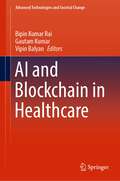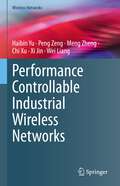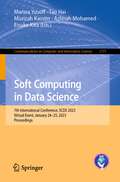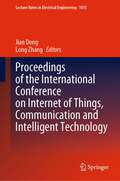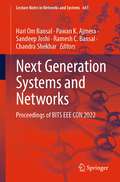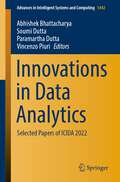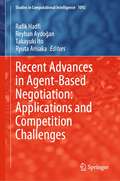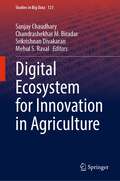- Table View
- List View
Paradigms of Smart and Intelligent Communication, 5G and Beyond (Transactions on Computer Systems and Networks)
by Amrita Rai Dinesh Kumar Singh Amit Sehgal Korhan CengizThis book focuses on both theory and applications of Artificial Intelligence and Machine Learning in the broad areas of communication and networking. This book focuses on the ongoing research work and future scope for various open research issues related to sustainable design, development, and analysis of smart communication, 5G and beyond, with the integration of Artificial intelligence and IoT. It addresses fundamental technology components for 5G and beyond, which include modern advancements in communication and networking in a real-world application. The book presents the convergence of Artificial Intelligence, Machine Learning, and IoT with 5G and beyond wireless networks to give some ice-breaking solutions in radio resource allocation, network management, and cybersecurity. This book will be a valuable resource for academicians, researchers, and professionals working in artificial intelligence/machine learning and its applications in communication and 5G.
A Gentle Introduction to Group Theory
by Bana Al Subaiei Muneerah Al NuwairanThe book is intended to serve as an introductory course in group theory geared towards second-year university students. It aims to provide them with the background needed to pursue more advanced courses in algebra and to provide a rich source of examples and exercises. Studying group theory began in the late eighteenth century and is still gaining importance due to its applications in physics, chemistry, geometry, and many fields in mathematics. The text is broadly divided into three parts. The first part establishes the prerequisite knowledge required to study group theory. This includes topics in set theory, geometry, and number theory. Each of the chapters ends with solved and unsolved exercises relating to the topic. By doing this, the authors hope to fill the gaps between all the branches in mathematics that are linked to group theory. The second part is the core of the book which discusses topics on semigroups, groups, symmetric groups, subgroups, homomorphisms, isomorphism, and Abelian groups. The last part of the book introduces SAGE, a mathematical software that is used to solve group theory problems. Here, most of the important commands in SAGE are explained, and many examples and exercises are provided.
Multigate Transistors for High Frequency Applications (Springer Tracts in Electrical and Electronics Engineering)
by K. Sivasankaran Partha Sharathi MallickThis book discusses the evolution of multigate transistors, the design challenges of transistors for high-frequency applications, and the design and modeling of multigate transistors for high-frequency applications. The contents particularly focus on the cut-off frequency and maximum oscillation frequency of different multigate structures. RF stability modeling for multigate transistors is presented, which can help to understand the relation between the small-signal parameter and the physical parameter of the device for optimization. This is a useful reference to those in academia and industry.
Hypergraph Computation (Artificial Intelligence: Foundations, Theory, and Algorithms)
by Qionghai Dai Yue GaoThis open access book discusses the theory and methods of hypergraph computation. Many underlying relationships among data can be represented using graphs, for example in the areas including computer vision, molecular chemistry, molecular biology, etc. In the last decade, methods like graph-based learning and neural network methods have been developed to process such data, they are particularly suitable for handling relational learning tasks. In many real-world problems, however, relationships among the objects of our interest are more complex than pair-wise. Naively squeezing the complex relationships into pairwise ones will inevitably lead to loss of information which can be expected valuable for learning tasks. Hypergraph, as a generation of graph, has shown superior performance on modelling complex correlations compared with graph. Recent years have witnessed a great popularity of researches on hypergraph-related AI methods, which have been used in computer vision, social media analysis, etc. We summarize these attempts as a new computing paradigm, called hypergraph computation, which is to formulate the high-order correlations underneath the data using hypergraph, and then conduct semantic computing on the hypergraph for different applications. The content of this book consists of hypergraph computation paradigms, hypergraph modelling, hypergraph structure evolution, hypergraph neural networks, and applications of hypergraph computation in different fields. We further summarize recent achievements and future directions on hypergraph computation in this book.
Machine Vision and Augmented Intelligence: Select Proceedings of MAI 2022 (Lecture Notes in Electrical Engineering #1007)
by Koushlendra Kumar Singh Manish Kumar Bajpai Akbar Sheikh AkbariThis book comprises the proceedings of the International Conference on Machine Vision and Augmented Intelligence (MAI 2022). The conference proceedings encapsulate the best deliberations held during the conference. The diversity of participants in the event from academia, industry, and research reflects in the articles appearing in the book. The book encompasses all industrial and non-industrial applications. This book covers a wide range of topics such as modeling of disease transformation, epidemic forecast, image processing, and computer vision, augmented intelligence, soft computing, deep learning, image reconstruction, artificial intelligence in health care, brain-computer interface, cybersecurity, social network analysis, and natural language processing.
Digital Economy Post COVID-19 Era: Proceedings of 8th Conference of Indian Academy of Management (INDAM2023), Mumbai, India 2023 (Springer Proceedings in Business and Economics)
by Prashant Mishra Ashu Sharma Sayantan Khanra Sumit K. Kundu Sushanta Kumar MishraThis book presents the future directions of the digital economy post Covid-19 era. The chapters of this book cover contemporary topics on digital economy and digital initiatives undertaken by various organizations. Overall, the book shares insights on how organizations can adapt and transform their processes, structure, and strategies to remain relevant and competitive in the new business and economic environment. These insights also emerge from multidisciplinary discussions in various management domains, such as, consumer behaviour and marketing, economics, finance and accounting, entrepreneurship and small business management, environmental, social and governance compliance, future of work, human resource management, leadership, inclusive workforce, information systems and decision sciences, international business and strategy, and operations and supply chain management.
Internet of Things Enabled Antennas for Biomedical Devices and Systems: Impact, Challenges and Applications (Springer Tracts in Electrical and Electronics Engineering)
by Praveen K. Malik Prasad N. ShastryThe book consists of the latest research in biomedical and communication integration. It discusses the fabrication and testing outcomes of the Internet of Things-enabled biomedical applications. The book focuses on recent advances in the field of planar antenna design and their applications in space communication, mobile communication, wireless communication, and wearable applications. Planar antennas are also used in medical applications in microwave imaging, medical implants, hyperthermia treatments, and wireless wellness monitoring. This book presents planar antenna design concepts, methods, and techniques to enhance the performance parameters and applications for IoT and device-to-device communication. It provides the latest techniques used for the design of antennas in terms of their structures, defected ground, MIMO, and fractal design. This book also addresses the specific steps to resolve issues in designing antennas and how to design conformal and miniaturized antenna structures for various applications.
Real-Time Simulation and Hardware-in-the-Loop Testing Using Typhoon HIL (Transactions on Computer Systems and Networks)
by Saurabh Mani Tripathi Francisco M. Gonzalez-LongattThis book is an edited collection that explores the fundamental concepts of real-time simulation/hardware-in-the-loop testing using ‘Typhoon HIL’ for complex electrical systems. Typhoon HIL has recently emerged as a powerful tool in the rapidly growing field of ultra-high-fidelity controller-hardware-in-the-loop (C-HIL) simulations for power electronics, microgrids, and distribution networks. The book integrates the coverage of underlying theory and acclaimed methodological approaches and high-value applications of real-time simulation and hardware-in-the-loop testing—all from the perspectives of eminent researchers around the globe utilizing Typhoon HIL. This book serves as a valuable resource for engineers, academicians, researchers, experienced professionals, and research scholars engaged in /becoming familiarized with the real-time simulation of complex electrical systems using Typhoon HIL with a specific focus on hardware-in-the-loop testing.
Robotics, Control and Computer Vision: Select Proceedings of ICRCCV 2022 (Lecture Notes in Electrical Engineering #1009)
by Hariharan Muthusamy János Botzheim Richi NayakThis book presents select peer-reviewed papers from the International Conference on Robotics, Control, and Computer Vision (ICRCCV 2022). The contents focus on the latest research in the field of Robotics, their control, and computer vision in the context of robotics. The contributed papers have been arranged to give a flow to the reader. This book will be useful for students, researchers, and professionals from multidisciplinary fields such as mechanical engineering, electronics engineering, electrical engineering, computer science, and mathematics.
Digital Twin Driven Intelligent Systems and Emerging Metaverse
by Enis Karaarslan Ömer Aydin Ümit Cali Moharram ChallengerThis book covers the notion of the digital twin, which has the potential to alter the way systems are governed and manufactured. It also addresses the metaverse as an emerging technology with its roots in literature, cross-platform avatars, and artificial intelligence-oriented cybersecurity issues. The untapped potential of the metaverse and digital twins as enabling technologies for the next-generation industries is emphasized in various chapters. Digital twin technology enables manufacturers to comprehend their products throughout product design better, integrate simulation, tracking, and optimization in real-time, and appropriately analyze operations. Especially for complicated products or systems, testing on a digital twin is more efficient (more accessible, quicker, less error-prone, and less expensive). The product is examined in its virtual version before it is displayed in the actual world. Additionally, the digital twin minimizes operational expenses and increases the longevity of equipment and assets. By prolonging the life of the thing, they represent and enhance its working efficiency; it may minimize operating costs and prospective capital spending. The digital twin idea is becoming a reality as it has begun to be used in several industries, including energy, manufacturing, construction, transportation, aerospace, smart cities, healthcare, cyber security, finance, and agriculture. Academic and industrial experts highlighted the most compelling use cases of digital twins and metaverses and the challenges inherent in their implementation. Readers who want to make more effective systems will find the book useful. Also, people who want to get an idea and vision of how technology will change our lives will benefit from this book.
Ubiquitous Security: Second International Conference, UbiSec 2022, Zhangjiajie, China, December 28–31, 2022, Revised Selected Papers (Communications in Computer and Information Science #1768)
by Guojun Wang Kim-Kwang Raymond Choo Jie Wu Ernesto DamianiThis book constitutes the refereed proceedings of the Second International Conference, UbiSec 2022, held in Zhangjiajie, China, during December 28–31, 2022.The 34 full papers and 4 short papers included in this book were carefully reviewed and selected from 98 submissions. They were organized in topical sections as follows: cyberspace security, cyberspace privacy, cyberspace anonymity and short papers.
Deep Cognitive Networks: Enhance Deep Learning by Modeling Human Cognitive Mechanism (SpringerBriefs in Computer Science)
by Yan Huang Liang WangAlthough deep learning models have achieved great progress in vision, speech, language, planning, control, and many other areas, there still exists a large performance gap between deep learning models and the human cognitive system. Many researchers argue that one of the major reasons accounting for the performance gap is that deep learning models and the human cognitive system process visual information in very different ways. To mimic the performance gap, since 2014, there has been a trend to model various cognitive mechanisms from cognitive neuroscience, e.g., attention, memory, reasoning, and decision, based on deep learning models. This book unifies these new kinds of deep learning models and calls them deep cognitive networks, which model various human cognitive mechanisms based on deep learning models. As a result, various cognitive functions are implemented, e.g., selective extraction, knowledge reuse, and problem solving, for more effective information processing. This book first summarizes existing evidence of human cognitive mechanism modeling from cognitive psychology and proposes a general framework of deep cognitive networks that jointly considers multiple cognitive mechanisms. Then, it analyzes related works and focuses primarily but not exclusively, on the taxonomy of four key cognitive mechanisms (i.e., attention, memory, reasoning, and decision) surrounding deep cognitive networks. Finally, this book studies two representative cases of applying deep cognitive networks to the task of image-text matching and discusses important future directions.
Intelligent Robotics: Third China Annual Conference, CCF CIRAC 2022, Xi’an, China, December 16–18, 2022, Proceedings (Communications in Computer and Information Science #1770)
by Zhiwen Yu Xinhong Hei Duanling Li Xianhua Song Zeguang LuThis book constitutes selected papers presented during the Third China Annual Intelligent Robotics Conference, CCF CIRAC 2022, held in Xi' an, China, in December 2022. The 35 papers presented were thoroughly reviewed and selected from the 120 qualified submissions. They are organized in the following topical sections: robot safety; intelligent robot sensing; autonomous robot navigation; artificial intelligence and cloud robot; unmanned cluster collaboration; natural human-computer interaction; other robot-related technologies.
Adopting and Adapting Innovation in Japan's Digital Transformation (Economics, Law, and Institutions in Asia Pacific)
by Anshuman Khare William W. BaberThis book explores how the business transformation taking place in Japan is influenced by the digital revolution. The chapters present approaches and examples from sectors commonly understood to be visible arenas of digital transformation—3D printing and mobility, for instance—as well as some from not-so-obvious sectors, such as retail, services, and fintech.Business today is facing unprecedented change especially due to the adoption of new, digital technologies, with a noticeable transformation of manufacturing and services. The changes have been brought by advanced robotics, the emergence of artificial intelligence, and digital networks that are growing in size and capability as the number of connected devices explodes. In addition, there are advanced manufacturing and collaborative connected platforms, including machine-to-machine communications. Adoption of digital technology has caused process disruptions in both the manufacturing and services sectors and led to new business models and new products. While examining the preparedness of the Japanese economy to embrace these changes, the book explores the impact of digitally influenced changes on some selected sectors from a Japanese perspective. It paints a big picture in explaining how a previously manufacturing-centric, successful economy adopts change to retain and rebuild success in the global environment. Japan as a whole is embracing, yet also avoiding—innovating but also restricting—various forms of digitalization of life and work. The book, with its 12 chapters, is a collaborative effort of individuals contributing diverse points of view as technologists, academics, and managers.
Marketing and Smart Technologies: Proceedings of ICMarkTech 2022, Volume 1 (Smart Innovation, Systems and Technologies #344)
by José Luís Reis Marisa Del Rio Araujo Luís Paulo Reis José Paulo Marques dos SantosThis book includes selected papers presented at the International Conference on Marketing and Technologies (ICMarkTech 2022), held at Universidade de Santiago de Compostela, Spain, during 1 – 3 December 2022. It covers up-to-date cutting-edge research on artificial intelligence applied in marketing, virtual and augmented reality in marketing, business intelligence databases and marketing, data mining and big data, marketing data science, web marketing, e-commerce and v-commerce, social media and networking, geomarketing and IoT, marketing automation and inbound marketing, machine learning applied to marketing, customer data management and CRM, and neuromarketing technologies.
Advances in Tourism, Technology and Systems: Selected Papers from ICOTTS 2022, Volume 1 (Smart Innovation, Systems and Technologies #345)
by João Vidal Carvalho António Abreu Pedro Liberato Alejandro PeñaThis book features a collection of high-quality research papers presented at the International Conference on Tourism, Technology and Systems (ICOTTS 2022), held at University of Chile, Santiago de Chile, Chile, from 3 to 5 November 2022. The book is divided into two volumes, and it covers the areas of technology in tourism and the tourist experience, generations and technology in tourism, digital marketing applied to tourism and travel, mobile technologies applied to sustainable tourism, information technologies in tourism, digital transformation of tourism business, e-tourism and tourism 2.0, big data and management for travel and tourism, geotagging and tourist mobility, smart destinations, robotics in tourism, and information systems and technologies.
Artificial Intelligence in Medical Virology (Medical Virology: From Pathogenesis to Disease Control)
by Jyotir Moy Chatterjee Shailendra K. SaxenaThis book comprehensively reviews the potential of Artificial Intelligence (AI) in biomedical research and healthcare, with a major emphasis on virology. The initial chapter presents the applications of machine learning methods for structured data, such as the classical support vector machine and neural network, modern deep learning, and natural language processing for unstructured data in biomedical research and healthcare. The subsequent chapters explore the applications of AI in tackling COVID-19, analysis of the pandemic, viral infection, disease spread, and control. The book further identifies the potential applications of machine learning in the field of virology with a focus on the key aspects of infection: diagnosis, transmission, response to treatment, and resistance. The book also discusses progress and challenges in developing viral vaccines and examines the application of viruses in translational research and human healthcare. Furthermore, the book covers the applications of artificial intelligence-mediated diagnosis and the development of drugs to treat the disease. Towards the end, the book summarizes the ethical and legal challenges posed by AI in healthcare and biomedical research. This book is an invaluable source for researchers, medical and industry practitioners, academicians, and students exploring the applications of AI in biomedical research and healthcare.
AI and Blockchain in Healthcare (Advanced Technologies and Societal Change)
by Bipin Kumar Rai Gautam Kumar Vipin BalyanThis book presents state-of-the-art blockchain and AI advances in health care. Healthcare service is increasingly creating the scope for blockchain and AI applications to enter the biomedical and healthcare world. Today, blockchain, AI, ML, and deep learning are affecting every domain. Through its cutting-edge applications, AI and ML are helping transform the healthcare industry for the better. Blockchain is a decentralization communication platform that has the potential to decentralize the way we store data and manage information. Blockchain technology has potential to reduce the role of middleman, one of the most important regulatory actors in our society. Transactions are simultaneously secure and trustworthy due to the use of cryptographic principles. In recent years, blockchain technology has become very trendy and has penetrated different domains, mostly due to the popularity of cryptocurrencies. One field where blockchain technology has tremendous potential is health care, due to the need for a more patient-centric approach in healthcare systems to connect disparate systems and to increase the accuracy of electronic healthcare records (EHRs).
Performance Controllable Industrial Wireless Networks (Wireless Networks)
by Haibin Yu Peng Zeng Meng Zheng Chi Xu Xi Jin Wei LiangWith the rapid proliferation of information and communications technology, industrial automation has undergone a sweeping transformation toward intelligent manufacturing. Wireless communication is widely considered to be one of the key technologies enabling intelligent manufacturing. On one hand, deterministic communication with high reliability and low latency is typically required in industrial automation applications. On the other hand, wireless communication in industrial settings is hindered by strictly limited communication resources and many other factors which mainly derive from the shared and error-prone nature of the wireless channels used. The limited communication resources and harsh channel conditions pose considerable challenges for reliable, real-time data transmission in industrial wireless networks. Resource optimization methods are vital to ensuring the deterministic performance of industrial wireless networks. Traditional resource optimization methods adopt the isolated resource optimization methods for each protocol layer, which is inherently local-optimal and leads performance uncontrollable. To focus on “Performance Controllable Industrial Wireless Networks”, this book presents thejoint resource optimization methods across multiple protocol layers for industrial wireless networks; reviews recent, major advances; and discusses the practical implementations of the proposed methods. The joint resource optimization methods discussed here will greatly benefit scientists and researchers in the areas of industrial automation and Industrial Internet of Things. To gain the most from this book, readers should have a fundamental grasp of wireless communication, scheduling theory, and convex optimization.
Soft Computing in Data Science: 7th International Conference, SCDS 2023, Virtual Event, January 24–25, 2023, Proceedings (Communications in Computer and Information Science #1771)
by Marina Yusoff Tao Hai Murizah Kassim Azlinah Mohamed Eisuke KitaThis book constitutes the refereed proceedings of the 7th International Conference on Soft Computing in Data Science, SCDS 2023, which was held virtually in January 2023. The 21 revised full papers presented were carefully reviewed and selected from 61 submissions. The papers are organized in topical sections on artificial intelligence techniques and applications; computing and optimization; data analytics and technologies; data mining and image processing; mathematical and statistical learning.
Proceedings of the International Conference on Internet of Things, Communication and Intelligent Technology (Lecture Notes in Electrical Engineering #1015)
by Jian Dong Long ZhangThis book includes original, peer-reviewed research papers from the International Conference on Internet of Things, Communication and Intelligent Technology (IoTCIT) 2022. It contains the application of communication and IoT engineering in the age of intelligent technology+ from the standpoint of disciplinary integration, combining theory and associated IoT and intelligent technology algorithms. The topics cover the full range of IoT solutions, from IoT to network security, and focus on many forms of communication, such as Next Generation (6G) Mobile Communication, D2D, and M2M Communication. Additionally, it examines Intelligent Technology, with a focus on Information System Modeling and Simulation. It also explores Cloud Computing, Pervasive and Mobile Computing, Distributed Computing, High Performance Computing, and Ubiquitous Computing.
Next Generation Systems and Networks: Proceedings of BITS EEE CON 2022 (Lecture Notes in Networks and Systems #641)
by Hari Om Bansal Pawan K. Ajmera Sandeep Joshi Ramesh C. Bansal Chandra ShekharThe book is a collection of high-quality research papers presented at International Conference on Next Generation Systems and Networks (BITS EEE CON 2022), held at Birla Institute of Technology & Science, Pilani, Rajasthan, India, during November 4–5, 2022. This book provides reliable and efficient design solutions for the next-generation networks and systems. The book covers research areas in energy, power and control; communication and signal processing; and electronics and nanotechnology.
Innovations in Data Analytics: Selected Papers of ICIDA 2022 (Advances in Intelligent Systems and Computing #1442)
by Abhishek Bhattacharya Soumi Dutta Paramartha Dutta Vincenzo PiuriThis book features research papers presented at the 1st International Conference on Innovations in Data Analytics (ICIDA 2022), held at Eminent College of Management and Technology (ECMT), West Bengal, India, during November 29–30, 2022. The book presents original research work in the areas of computational intelligence, advance computing, network security and telecommunication, data science and data analytics, and pattern recognition. The book is beneficial for readers from both academia and industry.
Recent Advances in Agent-Based Negotiation: Applications and Competition Challenges (Studies in Computational Intelligence #1092)
by Rafik Hadfi Reyhan Aydoğan Takayuki Ito Ryuta ArisakaThis book comprises carefully selected and reviewed outcomes of the 13th International Workshop on Automated Negotiations (ACAN) held in Vienna, 2022, in conjunction with International Joint Conference on Artificial Intelligence (IJCAI) 2022. It focuses on the applications and challenges of agent-based negotiation including agreement technology, mechanism design, electronic commerce, recommender systems, supply chain management, social choice theory, and others. This book is intended for the academic and industrial researchers of various communities of autonomous agents and multi-agent systems, as well as graduate students studying in those areas or having interest in them.
Digital Ecosystem for Innovation in Agriculture (Studies in Big Data #121)
by Sanjay Chaudhary Chandrashekhar M. Biradar Srikrishnan Divakaran Mehul S. RavalThis book presents the latest findings in the areas of digital ecosystem for innovation in agriculture. The book is organized into two sections with thirteen chapters dealing with specialized areas. It provides the reader with an overview of the frameworks and technologies involved in the digitalization of agriculture, as well as the data processing methods, decision-making processes, and innovative services/applications for enabling digital transformations in agriculture. The chapters are written by experts sharing their experiences in lucid language through case studies, suitable illustrations, and tables. The contents have been designed to fulfill the needs of geospatial, data science, agricultural, and environmental sciences of universities, agricultural universities, technological universities, research institutes, and academic colleges worldwide. It helps the planners, policymakers, and extension scientists plan and sustainably manage agriculture and natural resources.
